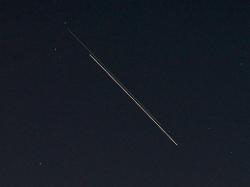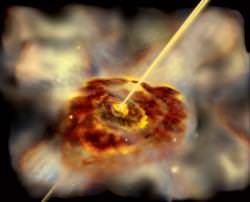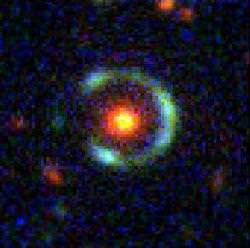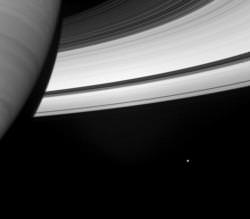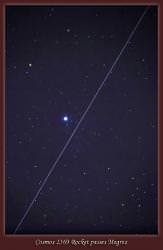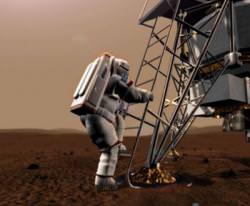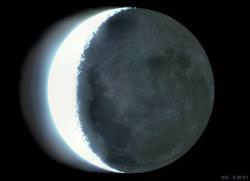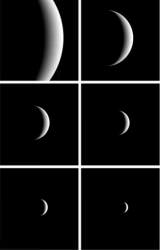Monday, June 18 – Mark your calendars for dusk tonight as brilliant Venus dances with the da Vinci Moon. The sparkling planet will be about one half degree south of the crescent and for some locations this could be an occultation! Be sure to check the IOTA website for locations and times in your area.
No special equipment is needed to see this event, and thanks to Leonardo da Vinci we can see the ghostly effect on the Moon as quite logical. He was the first to theorize that sunlight was reflecting off the Earth and illuminating the portion of the Moon not lit by the Sun. We more commonly refer to this as “Earthshine” – but no matter how scientific the explanations are for this phenomena, its appearance remains beautiful.
While you’re out tonight, take a look at the skies for a circlet of seven stars that reside about halfway between orange Arcturus and brilliant blue/white Vega. This quiet constellation is named Corona Borealis – or the “Northern Crown.” Just northwest of its brightest star is a huge concentration of over 400 galaxies that reside over a billion light-years away from us. This area is so small from our point of view that we could cover it with our thumbnails held at arm’s length!
Tuesday, June 19 – Just when you thought watching the sky couldn’t get any better… It does. Tonight the mighty Saturn will be less than one half degree from the Moon – and will present a splendid occultation opportunity for many observers. If you don’t have a chance to see this one, perhaps you will fare better with Regulus, which is also less than one half degree from the Moon and presents an occultation opportunity. Be sure to check IOTA for precise information. Even if an event doesn’t happen for your location, this will be a sight you won’t want to miss!
While you’re watching the event, be sure to take the time to view the lunar surface for a couple of telescopic challenges that are easy to catch – all you have to know is Mare Crisium! On the southeastern shoreline is a peninsula which reaches into Crisium’s dark basin. This is Promontorium Agarum. On the western shore, bright Proclus lights the banks, but look into the interior for the two dark pock marks of Pierce to the north and Picard to the south. Be sure to mark them on your notes!
When you’re finished, point your binoculars or telescopes back towards Corona Borealis and about three fingerwidths northwest of Alpha for variable star R (Ra 15. 48.6 Dec +28 09). This star is a total enigma. Discovered in 1795, most of the time R carries a magnitude near 6, but can drop to magnitude 14 in a matter of weeks – only to unexpectedly brighten again! It is believed that R emits a carbon cloud which blocks its light. When studied at minima, the light curve resembles a “reverse nova,” and has a peculiar spectrum. It is very possible this ancient Population II star has used all of its hydrogen fuel and is now fusing helium to carbon. It’s so odd that science can’t even directly determine its distance!
Wednesday, June 20 – With no Moon to contend with in the predawn hours, we welcome the “shooting stars” as we pass through another portion of the Ophiuchid meteor stream. The radiant for this pass will be nearer Sagittarius and the fall rate varies from 8 to 20, but it can sometimes produce unexpectedly more.
Tonight we’ll return again to the lunar surface first to pick off another study object on our list – Messier and Messier A.
Located in Mare Fecunditatis about 1/3 its width from west to east, this pair of twin craters will be difficult in binoculars, but not hard for even a small telescope and intermediate power. Indeed named for famed French astronomer, Charles Messier, the easternmost crater is somewhat oval in shape with dimensions of 9 by 11 kilometers. At high power, Messier A to the west appears to have overlapped a smaller crater during its formation and it is slightly larger at 11 by 13 kilometers. Although it is not on the challenge list, you’ll find another point of interest to the northwest. Rima Messier is a long surface crack which runs diagonally across Mare Fecunditatis’ northwestern flank and reaches a length of 100 kilometers.
For variable star fans, let’s return again to Corona Borealis and focus our attention on S – located just west of Theta – the westernmost star in the constellation’s arc formation. At magnitude 5.3, this long-term variable takes almost a year to go through its changes; usually far outshining the 7th magnitude star to its northeast – but will drop to a barely visible magnitude 14 at minimum. Compare it to the eclipsing binary U Coronae Borealis about a degree northwest. In slightly over three days this Algol-type will range by a full magnitude as its companions draw together.
Thursday, June 21 – Summer Solstice occurs today at 12:26 UT. So what exactly is it? Solstice is nothing more than an astronomical term for the moment when one hemisphere of the Earth is tilted the most toward the Sun. Today, the sun is about 24 degrees above the celestial equator – its highest point of the year. The day of summer solstice also has the longest period of daylight…and the shortest of night; this occurs around 6 months from now for the Southern Hemisphere.
If you haven’t had the chance to pick up crater Posidonius for your lunar studies, tonight would be a great time to power up and really study this ancient mountain-walled plain. Standing on the northeast shore of Mare Serenitatis near the terminator, this melted-down and lava-filled area looks very flat, with gently stepped walls. Still, it stretches an admirable 95 kilometers in diameter and drops to a depth of 2300 meters at the floor. During this sunrise phase, it is possible to spot some of the huge systems of rimae which line its floor, even in binoculars. This extended system of cracks gives mute testimony to Posidonius’ volcanic history, and several strikes – such as the A crater near the center – help this crater to show its age well!
Friday, June 22 – Today celebrates the founding of the Royal Greenwich Observatory in 1675. That’s 332 years of astronomy! Also on this date in history, in 1978, James Christy of the US Naval Observatory in Flagstaff Arizona discovered Pluto’s satellite Charon.
While observing Pluto is quite possible with a mid-sized (8″) telescope, careful work is needed to separate and identify it from field stars. Just a few days ago, Pluto reached opposition, meaning it is viewable all night. Since it will take several nights of observation for confirmation, right now would be an excellent time to begin your Pluto quest. With a little research you’ll find plenty of on-line locator charts to help guide you on your way!
If you observe the Moon tonight, be sure to note both Gemma Frisius and Maurolycus on your lunar challenge list. While at Gemma Frisius, let’s look for a little more “off the beaten path” crater about halfway towards Catharina. Under tonight’s lighting at low power, you’ll see it first as a sunken oval – but power up and let’s explore Sacrobosco.
Named for the English mathematician “John of Holywood” (Johannes Sacrobuschus), this class III crater spans 98 kilometers and drops down to a floor level of 2800 meters – making those crater walls about as high as the West Ridge of Mt. Everest. On its troubled floor you will see the evidence of three far newer impacts: Crater C to the north which spans 13 kilometers and drops down 2630 meters; Crater A to the west which is 18 kilometers in diameter and 1830 meters deep; and Crater B to the east at 15 kilometers wide and 1210 meters deep. While these strikes are fascinating…look again. Sacrobosco itself is imprinted over the top of a far older crater!
Saturday, June 23 – Our lunar challenge feature for this evening is prominent enough to be spotted in binoculars, but well worth the time to power up with the telescope and explore. Starting with the recognizable slash of the Alpine Valley, follow the mountain trail south to the double strike of crater Cassini.
Named for Giovanni Cassini, this smashing old Class V crater rises above the lunar topography by 1067 meters, making its shallow walls alone as tall as the Catskill Mountains. It covers about 57 kilometers of lunar landscape in its rough diameter and the crater floor is 1240 kilometers below the surface. At one time Cassini may very well have had a central peak, but something quite took care of that when it formed Cassini A. This double-stepped feature is 57 kilometers in diameter and drops down an additional 2830 meters. While both Cassini and Cassini A are lunar club challenges, look carefully for yet another interior crater. Small crater B is often referred to as the “Washbowl” for its almost perfect concave structure.
While we’re out, let’s have a look at Delta Serpens. To the eye and binoculars, 4th magnitude Delta is a widely separated visual double star… But power up in the telescope to have a look at a wonderfully difficult binary. Divided by no more than 4 arc seconds, 210 light-year distant Delta and its 5th magnitude companion could be as old as 800 million years and on the verge of becoming evolved giants. Separated by about 9 times the distance of Pluto from our Sun, the white primary is a Delta Scuti-type variable which changes subtly in less than four hours. Although it takes the pair 3200 years to orbit each other, you’ll find Delta Serpens to be an excellent challenge for your optics.
Sunday, June 24 – On this day in 1881, Sir William Huggins made the first photographic spectrum of a comet (1881 III) and discovered cyanogen (CN) emission at violet wavelengths. Unfortunately, his discovery caused public panic around 29 years later when Earth passed through the tail of Halley’s Comet. What a shame the public didn’t realize that cyanogens are also released organically! More than fearing what is in a comet’s tail, they should have been thinking about what might happen should a comet strike. Tonight look at the wasted Southern Highland area of the Moon with new eyes… Many of these craters you see were caused by impacts – some as large as the nucleus of Halley itself.
Now let’s turn binoculars or telescopes towards magnitude 2.7 Alpha Librae – the second brightest star in the celestial “Scales.” Its proper name is Zuben El Genubi, and even as “Star Wars” as that sounds, the “Southern Claw” is actually quite close to home at a distance of only 65 light-years.
No matter what size optics you are using, you’ll easily see Alpha’s 5th magnitude companion widely spaced and sharing the same proper motion. Alpha itself is a spectroscopic binary which was verified during an occultation event, and its inseparable companion is only a half magnitude dimmer according to the light curves. Enjoy this easy pair tonight!

